2010 BMW 335I XDRIVE CONVERTIBLE navigation
[x] Cancel search: navigationPage 195 of 266
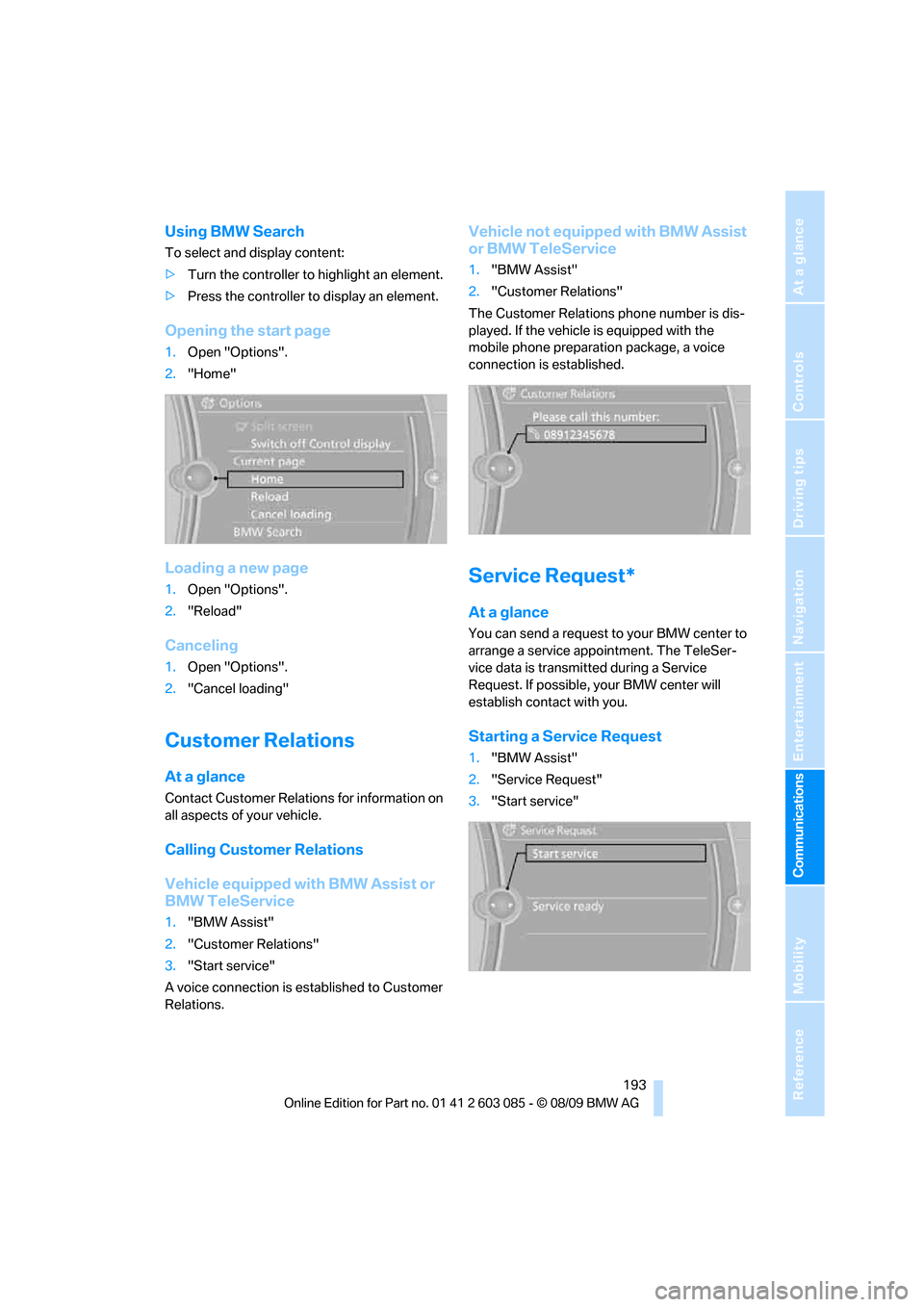
193
Entertainment
Reference
At a glance
Controls
Driving tips Communications
Navigation
Mobility
Using BMW Search
To select and display content:
>Turn the controller to highlight an element.
>Press the controller to display an element.
Opening the start page
1.Open "Options".
2."Home"
Loading a new page
1.Open "Options".
2."Reload"
Canceling
1.Open "Options".
2."Cancel loading"
Customer Relations
At a glance
Contact Customer Relations for information on
all aspects of your vehicle.
Calling Customer Relations
Vehicle equipped with BMW Assist or
BMW TeleService
1."BMW Assist"
2."Customer Relations"
3."Start service"
A voice connection is established to Customer
Relations.
Vehicle not equipped with BMW Assist
or BMW TeleService
1."BMW Assist"
2."Customer Relations"
The Customer Relations phone number is dis-
played. If the vehicle is equipped with the
mobile phone preparation package, a voice
connection is established.
Service Request*
At a glance
You can send a request to your BMW center to
arrange a service appointment. The TeleSer-
vice data is transmitted during a Service
Request. If possible, your BMW center will
establish contact with you.
Starting a Service Request
1."BMW Assist"
2."Service Request"
3."Start service"
Page 197 of 266

195
Entertainment
Reference
At a glance
Controls
Driving tips Communications
Navigation
Mobility
Page 201 of 266
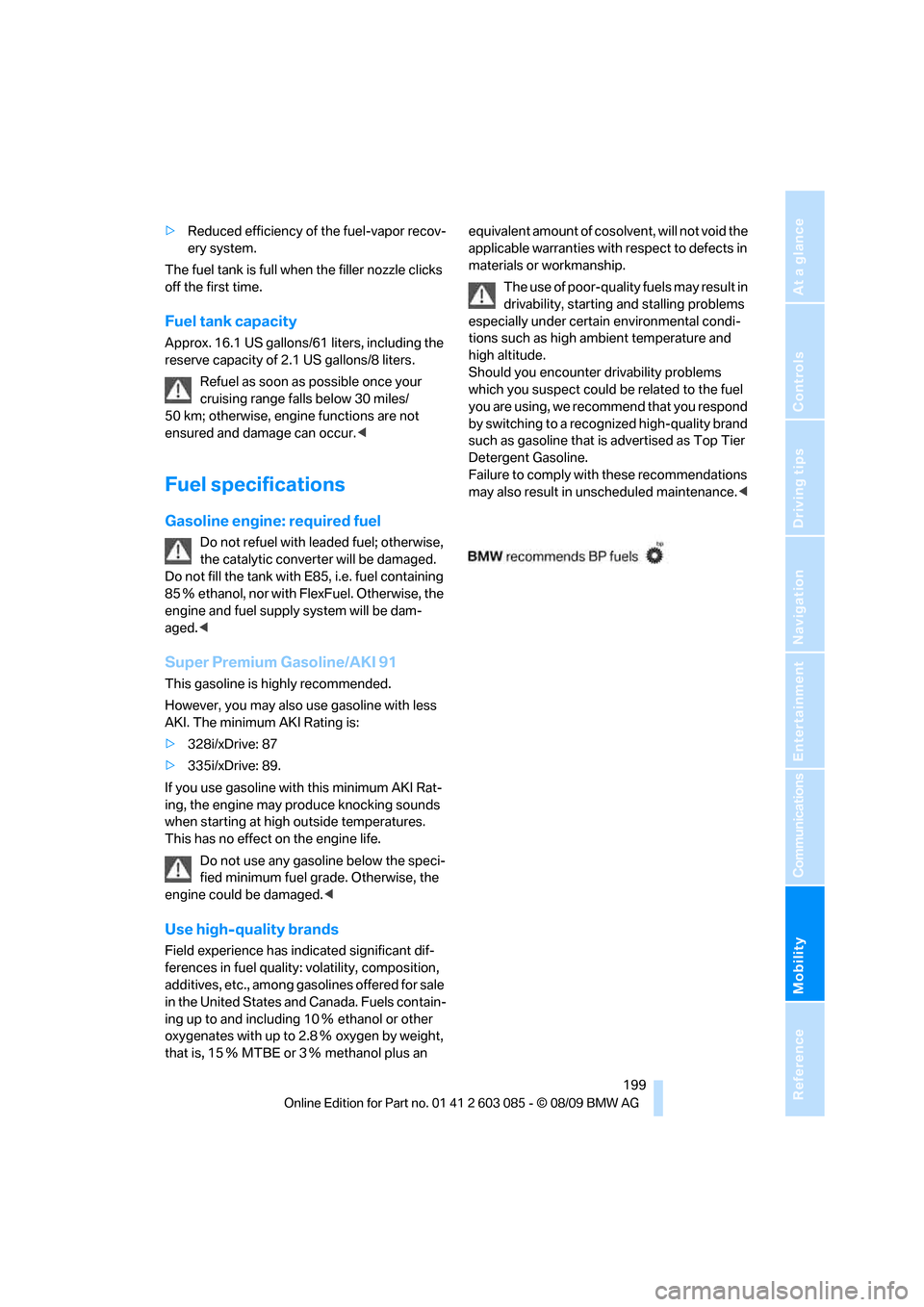
Mobility
199Reference
At a glance
Controls
Driving tips
Communications
Navigation
Entertainment
>Reduced efficiency of the fuel-vapor recov-
ery system.
The fuel tank is full when the filler nozzle clicks
off the first time.
Fuel tank capacity
Approx. 16.1 US gallons/61 liters, including the
reserve capacity of 2.1 US gallons/8 liters.
Refuel as soon as possible once your
cruising range falls below 30 miles/
50 km; otherwise, engine functions are not
ensured and damage can occur.<
Fuel specifications
Gasoline engine: required fuel
Do not refuel with leaded fuel; otherwise,
the catalytic converter will be damaged.
Do not fill the tank with E85, i.e. fuel containing
85Ξ ethanol, nor with FlexFuel. Otherwise, the
engine and fuel supply system will be dam-
aged.<
Super Premium Gasoline/AKI 91
This gasoline is highly recommended.
However, you may also use gasoline with less
AKI. The minimum AKI Rating is:
>328i/xDrive: 87
>335i/xDrive: 89.
If you use gasoline with this minimum AKI Rat-
ing, the engine may produce knocking sounds
when starting at high outside temperatures.
This has no effect on the engine life.
Do not use any gasoline below the speci-
fied minimum fuel grade. Otherwise, the
engine could be damaged.<
Use high-quality brands
Field experience has indicated significant dif-
ferences in fuel quality: volatility, composition,
additives, etc., among gasolines offered for sale
in the United States and Canada. Fuels contain-
ing up to and including 10Ξ ethanol or other
oxygenates with up to 2.8Ξ oxygen by weight,
that is, 15Ξ MTBE or 3Ξ methanol plus an equivalent amount of cosolvent, will not void the
applicable warranties with respect to defects in
materials or workmanship.
The use of poor-quality fuels may result in
drivability, starting and stalling problems
especially under certain environmental condi-
tions such as high ambient temperature and
high altitude.
Should you encounter drivability problems
which you suspect could be related to the fuel
you are using, we recommend that you respond
by switching to a recognized high-quality brand
such as gasoline that is advertised as Top Tier
Detergent Gasoline.
Failure to comply with these recommendations
may also result in unscheduled maintenance.<
Page 203 of 266
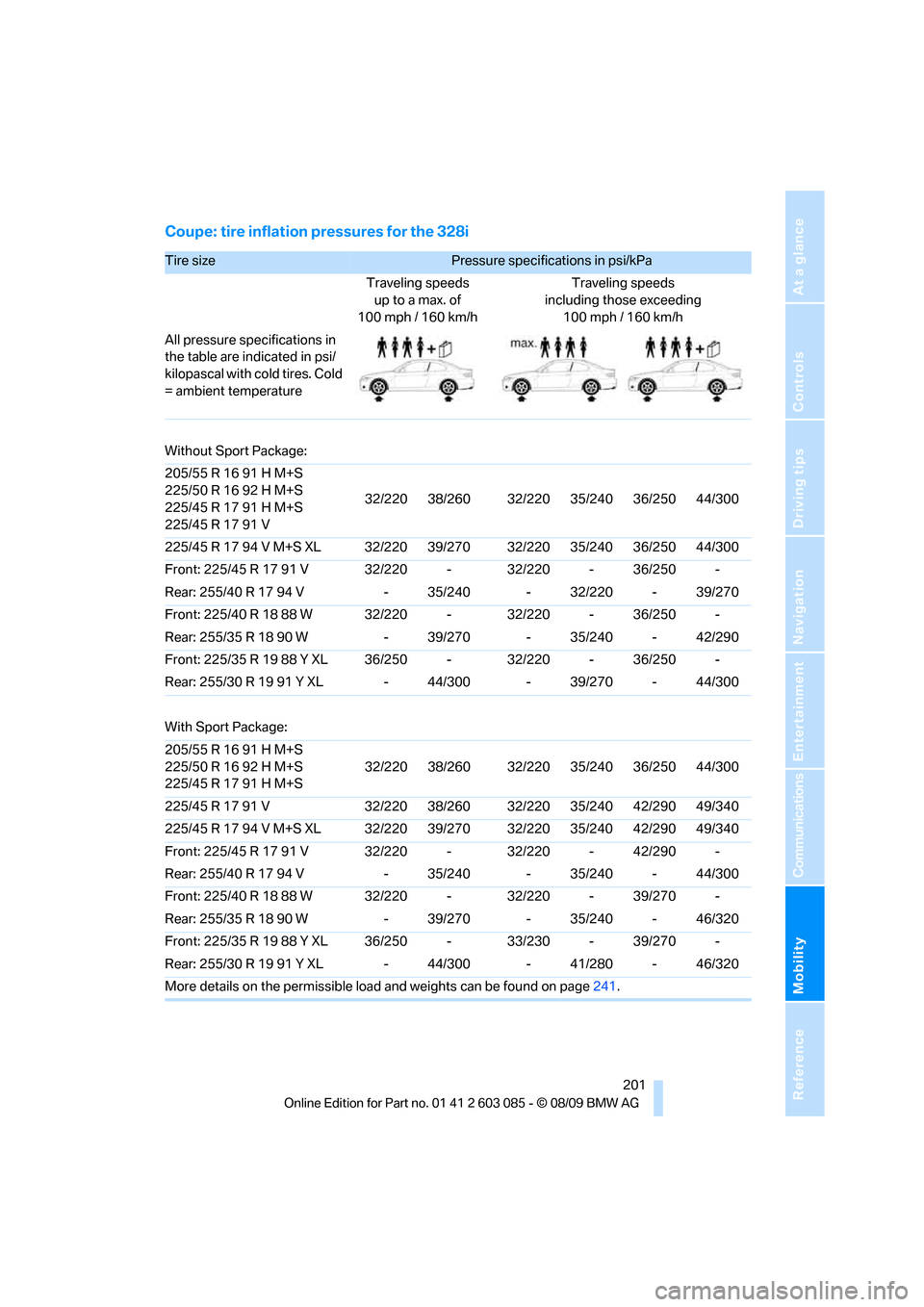
Mobility
201Reference
At a glance
Controls
Driving tips
Communications
Navigation
Entertainment
Coupe: tire inflation pressures for the 328i
Tire size Pressure specifications in psi/kPa
Traveling speeds
up to a max. of
100 mph / 160 km/hTraveling speeds
including those exceeding
100mph / 160km/h
All pressure specifications in
the table are indicated in psi/
kilopascal with cold tires. Cold
= ambient temperature
Without Sport Package:
205/55 R 16 91 H M+S
225/50 R 16 92 H M+S
225/45 R 17 91 H M+S
225/45 R 17 91 V32/220 38/260 32/220 35/240 36/250 44/300
225/45 R 17 94 V M+S XL 32/220 39/270 32/220 35/240 36/250 44/300
Front: 225/45 R 17 91 V 32/220 - 32/220 - 36/250 -
Rear: 255/40 R 17 94 V - 35/240 - 32/220 - 39/270
Front: 225/40 R 18 88 W 32/220 - 32/220 - 36/250 -
Rear: 255/35 R 18 90 W - 39/270 - 35/240 - 42/290
Front: 225/35 R 19 88 Y XL 36/250 - 32/220 - 36/250 -
Rear: 255/30 R 19 91 Y XL - 44/300 - 39/270 - 44/300
With Sport Package:
205/55 R 16 91 H M+S
225/50 R 16 92 H M+S
225/45 R 17 91 H M+S32/220 38/260 32/220 35/240 36/250 44/300
225/45 R 17 91 V 32/220 38/260 32/220 35/240 42/290 49/340
225/45 R 17 94 V M+S XL 32/220 39/270 32/220 35/240 42/290 49/340
Front: 225/45 R 17 91 V 32/220 - 32/220 - 42/290 -
Rear: 255/40 R 17 94 V - 35/240 - 35/240 - 44/300
Front: 225/40 R 18 88 W 32/220 - 32/220 - 39/270 -
Rear: 255/35 R 18 90 W - 39/270 - 35/240 - 46/320
Front: 225/35 R 19 88 Y XL 36/250 - 33/230 - 39/270 -
Rear: 255/30 R 19 91 Y XL - 44/300 - 41/280 - 46/320
More details on the permissible load and weights can be found on page241.
Page 205 of 266

Mobility
203Reference
At a glance
Controls
Driving tips
Communications
Navigation
Entertainment
Coupe: tire inflation pressures for the 335i
Tire size Pressure specifications in psi/kPa
Traveling speeds
up to a max. of
100 mph / 160 km/hTraveling speeds
including those exceeding
100mph / 160km/h
All pressure specifications in
the table are indicated in psi/
kilopascal with cold tires. Cold
= ambient temperature
Without Sport Package:
225/45 R 17 91 H M+S 32/220 39/270 32/220 35/240 38/260 45/310
225/45 R 17 94 V M+S XL 33/230 41/280 32/220 35/240 38/260 45/310
Front: 225/45 R 17 91 V 32/220 - 32/220 - 38/260 -
Rear: 255/40 R 17 94 V - 35/240 - 32/220 - 41/280
Front: 225/40 R 18 88 W 32/220 - 32/220 - 38/260 -
Rear: 255/35 R 18 90 W - 39/270 - 35/240 - 45/310
Front: 225/40 R 18 88 Y 32/220 - 32/220 - 35/240 -
Rear: 255/35 R 18 90 Y - 39/270 - 32/220 - 41/280
Front: 225/35 R 19 88 Y XL 38/260 - 33/230 - 38/260 -
Rear: 255/30 R 19 91 Y XL - 45/310 - 41/280 - 45/310
With Sport Package:
225/45 R 17 91 H M+S 32/220 39/270 32/220 35/240 38/260 45/310
225/45 R 17 94 V M+S XL 33/230 41/280 33/230 36/250 42/290 49/340
Front: 225/45 R 17 91 V 32/220 - 32/220 - 38/260 -
Rear: 255/40 R 17 94 V - 35/240 - 35/240 - 44/300
Front: 225/40 R 18 88 W 32/220 - 35/240 - 41/280 -
Rear: 255/35 R 18 90 W - 39/270 - 38/260 - 48/330
Front: 225/40 R 18 88 Y 32/220 - 32/220 - 36/250 -
Rear: 255/35 R 18 90 Y - 39/270 - 35/240 - 44/300
Front: 225/35 R 19 88 Y XL 38/260 - 36/250 - 41/280 -
Rear: 255/30 R 19 91 Y XL - 45/310 - 44/300 - 48/330
More details on the permissible load and weights can be found on page241.
Page 207 of 266
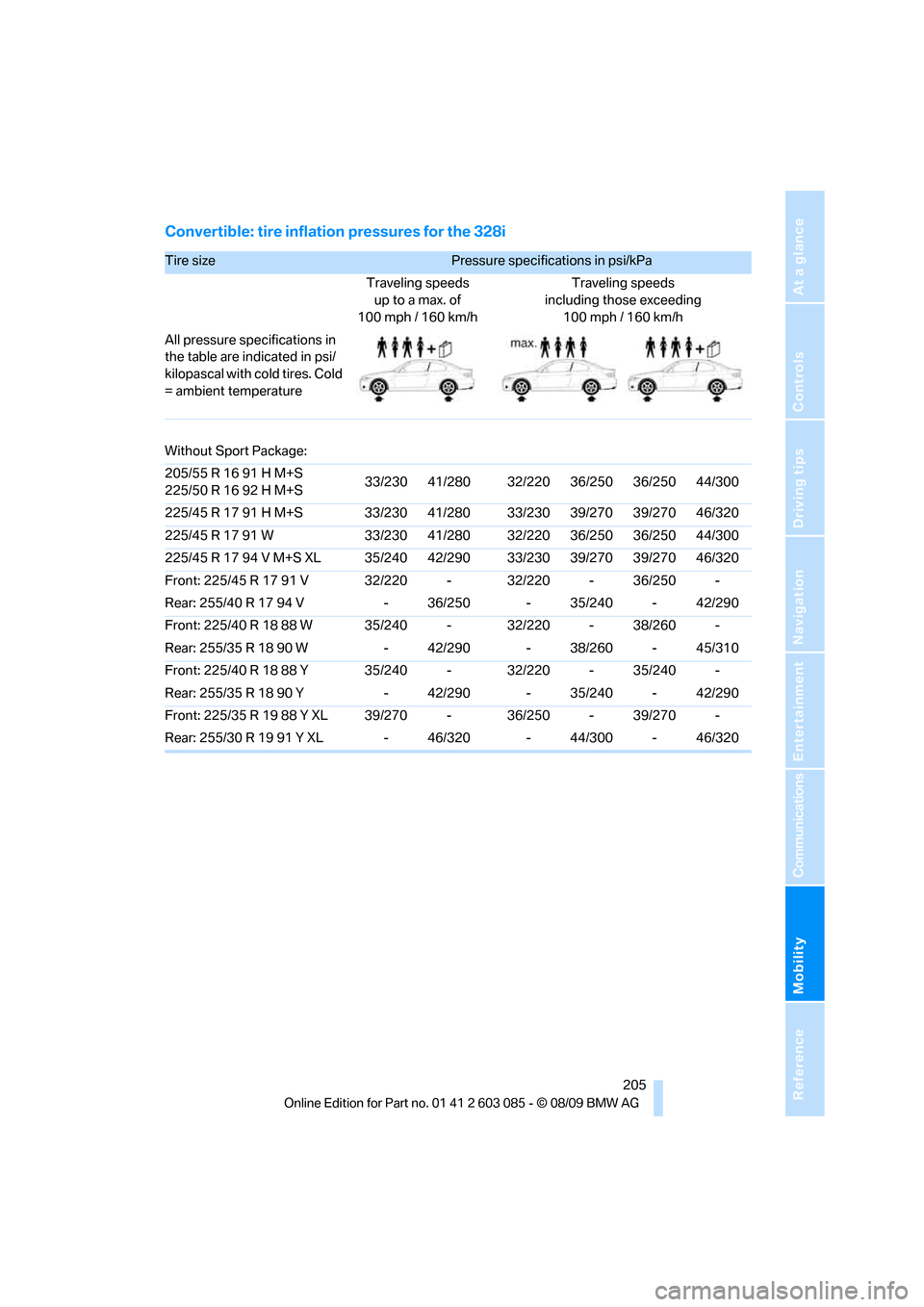
Mobility
205Reference
At a glance
Controls
Driving tips
Communications
Navigation
Entertainment
Convertible: tire inflation pressures for the 328i
Tire size Pressure specifications in psi/kPa
Traveling speeds
up to a max. of
100 mph / 160 km/hTraveling speeds
including those exceeding
100mph / 160km/h
All pressure specifications in
the table are indicated in psi/
kilopascal with cold tires. Cold
= ambient temperature
Without Sport Package:
205/55 R 16 91 H M+S
225/50 R 16 92 H M+S33/230 41/280 32/220 36/250 36/250 44/300
225/45 R 17 91 H M+S 33/230 41/280 33/230 39/270 39/270 46/320
225/45 R 17 91 W 33/230 41/280 32/220 36/250 36/250 44/300
225/45 R 17 94 V M+S XL 35/240 42/290 33/230 39/270 39/270 46/320
Front: 225/45 R 17 91 V 32/220 - 32/220 - 36/250 -
Rear: 255/40 R 17 94 V - 36/250 - 35/240 - 42/290
Front: 225/40 R 18 88 W 35/240 - 32/220 - 38/260 -
Rear: 255/35 R 18 90 W - 42/290 - 38/260 - 45/310
Front: 225/40 R 18 88 Y 35/240 - 32/220 - 35/240 -
Rear: 255/35 R 18 90 Y - 42/290 - 35/240 - 42/290
Front: 225/35 R 19 88 Y XL 39/270 - 36/250 - 39/270 -
Rear: 255/30 R 19 91 Y XL - 46/320 - 44/300 - 46/320
Page 209 of 266
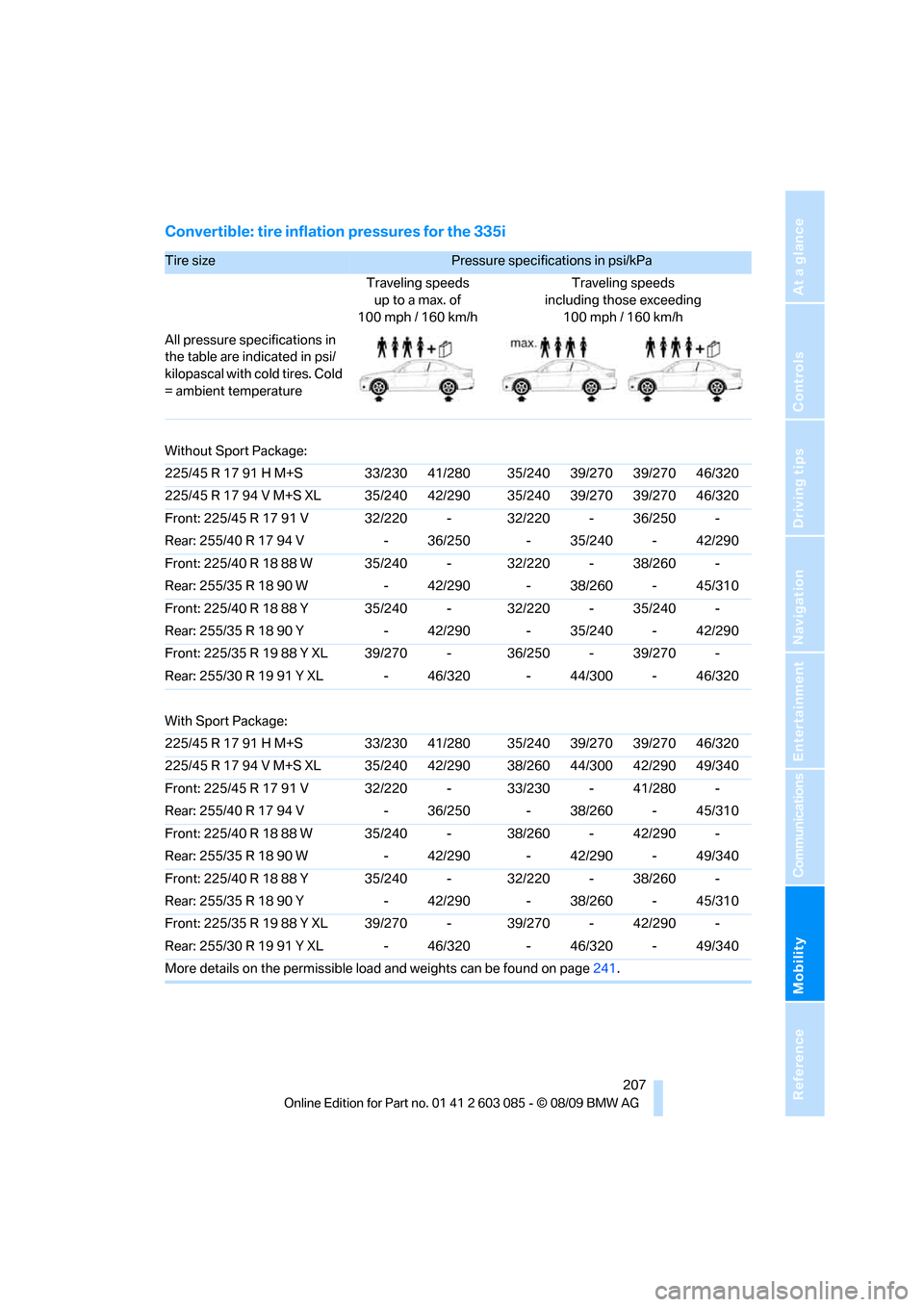
Mobility
207Reference
At a glance
Controls
Driving tips
Communications
Navigation
Entertainment
Convertible: tire inflation pressures for the 335i
Tire size Pressure specifications in psi/kPa
Traveling speeds
up to a max. of
100 mph / 160 km/hTraveling speeds
including those exceeding
100mph / 160km/h
All pressure specifications in
the table are indicated in psi/
kilopascal with cold tires. Cold
= ambient temperature
Without Sport Package:
225/45 R 17 91 H M+S 33/230 41/280 35/240 39/270 39/270 46/320
225/45 R 17 94 V M+S XL 35/240 42/290 35/240 39/270 39/270 46/320
Front: 225/45 R 17 91 V 32/220 - 32/220 - 36/250 -
Rear: 255/40 R 17 94 V - 36/250 - 35/240 - 42/290
Front: 225/40 R 18 88 W 35/240 - 32/220 - 38/260 -
Rear: 255/35 R 18 90 W - 42/290 - 38/260 - 45/310
Front: 225/40 R 18 88 Y 35/240 - 32/220 - 35/240 -
Rear: 255/35 R 18 90 Y - 42/290 - 35/240 - 42/290
Front: 225/35 R 19 88 Y XL 39/270 - 36/250 - 39/270 -
Rear: 255/30 R 19 91 Y XL - 46/320 - 44/300 - 46/320
With Sport Package:
225/45 R 17 91 H M+S 33/230 41/280 35/240 39/270 39/270 46/320
225/45 R 17 94 V M+S XL 35/240 42/290 38/260 44/300 42/290 49/340
Front: 225/45 R 17 91 V 32/220 - 33/230 - 41/280 -
Rear: 255/40 R 17 94 V - 36/250 - 38/260 - 45/310
Front: 225/40 R 18 88 W 35/240 - 38/260 - 42/290 -
Rear: 255/35 R 18 90 W - 42/290 - 42/290 - 49/340
Front: 225/40 R 18 88 Y 35/240 - 32/220 - 38/260 -
Rear: 255/35 R 18 90 Y - 42/290 - 38/260 - 45/310
Front: 225/35 R 19 88 Y XL 39/270 - 39/270 - 42/290 -
Rear: 255/30 R 19 91 Y XL - 46/320 - 46/320 - 49/340
More details on the permissible load and weights can be found on page241.
Page 211 of 266
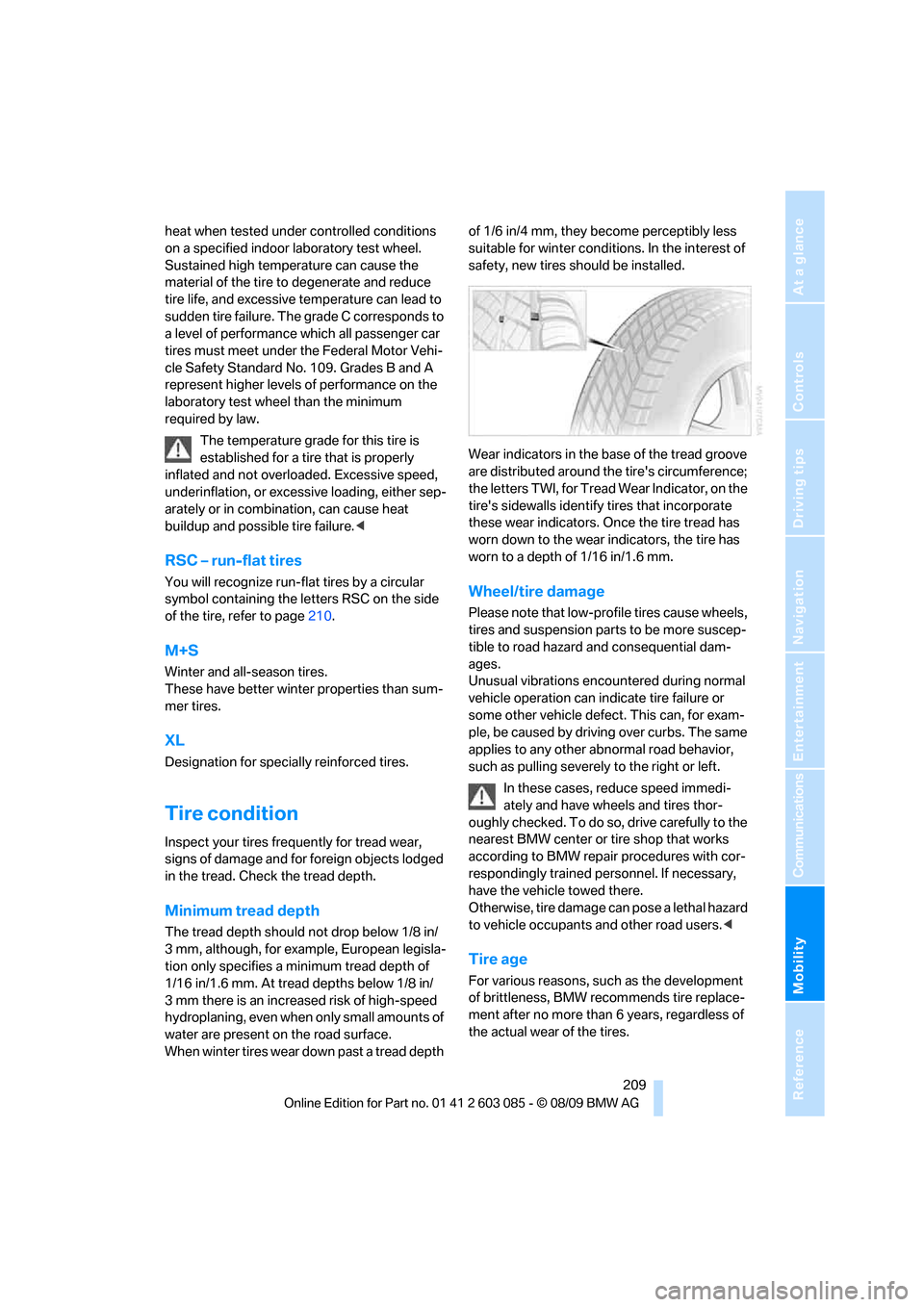
Mobility
209Reference
At a glance
Controls
Driving tips
Communications
Navigation
Entertainment
heat when tested under controlled conditions
on a specified indoor laboratory test wheel.
Sustained high temperature can cause the
material of the tire to degenerate and reduce
tire life, and excessive temperature can lead to
sudden tire failure. The grade C corresponds to
a level of performance which all passenger car
tires must meet under the Federal Motor Vehi-
cle Safety Standard No. 109. Grades B and A
represent higher levels of performance on the
laboratory test wheel than the minimum
required by law.
The temperature grade for this tire is
established for a tire that is properly
inflated and not overloaded. Excessive speed,
underinflation, or excessive loading, either sep-
arately or in combination, can cause heat
buildup and possible tire failure.<
RSC – run-flat tires
You will recognize run-flat tires by a circular
symbol containing the letters RSC on the side
of the tire, refer to page210.
M+S
Winter and all-season tires.
These have better winter properties than sum-
mer tires.
XL
Designation for specially reinforced tires.
Tire condition
Inspect your tires frequently for tread wear,
signs of damage and for foreign objects lodged
in the tread. Check the tread depth.
Minimum tread depth
The tread depth should not drop below 1/8 in/
3 mm, although, for example, European legisla-
tion only specifies a minimum tread depth of
1/16 in/1.6 mm. At tread depths below 1/8 in/
3 mm there is an increased risk of high-speed
hydroplaning, even when only small amounts of
water are present on the road surface.
When winter tires wear down past a tread depth of 1/6 in/4 mm, they become perceptibly less
suitable for winter conditions. In the interest of
safety, new tires should be installed.
Wear indicators in the base of the tread groove
are distributed around the tire's circumference;
the letters TWI, for Tread Wear Indicator, on the
tire's sidewalls identify tires that incorporate
these wear indicators. Once the tire tread has
worn down to the wear indicators, the tire has
worn to a depth of 1/16 in/1.6 mm.
Wheel/tire damage
Please note that low-profile tires cause wheels,
tires and suspension parts to be more suscep-
tible to road hazard and consequential dam-
ages.
Unusual vibrations encountered during normal
vehicle operation can indicate tire failure or
some other vehicle defect. This can, for exam-
ple, be caused by driving over curbs. The same
applies to any other abnormal road behavior,
such as pulling severely to the right or left.
In these cases, reduce speed immedi-
ately and have wheels and tires thor-
oughly checked. To do so, drive carefully to the
nearest BMW center or tire shop that works
according to BMW repair procedures with cor-
respondingly trained personnel. If necessary,
have the vehicle towed there.
Otherwise, tire damage can pose a lethal hazard
to vehicle occupants and other road users.<
Tire age
For various reasons, such as the development
of brittleness, BMW recommends tire replace-
ment after no more than 6 years, regardless of
the actual wear of the tires.